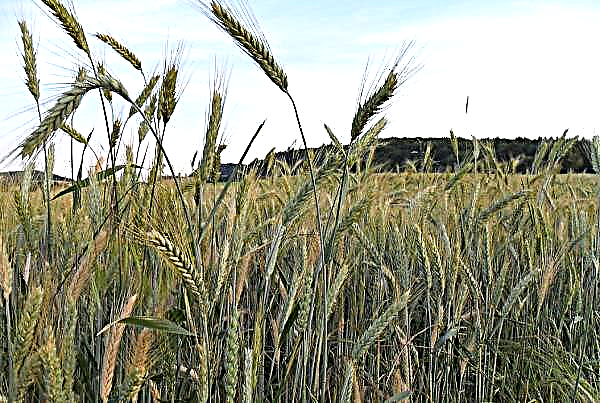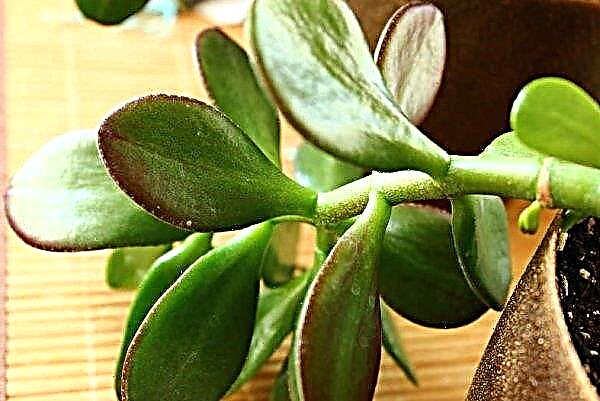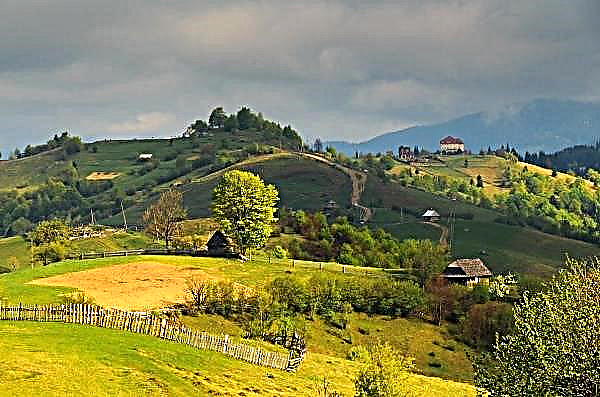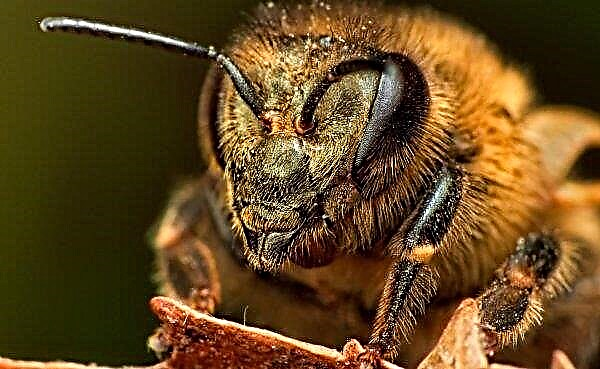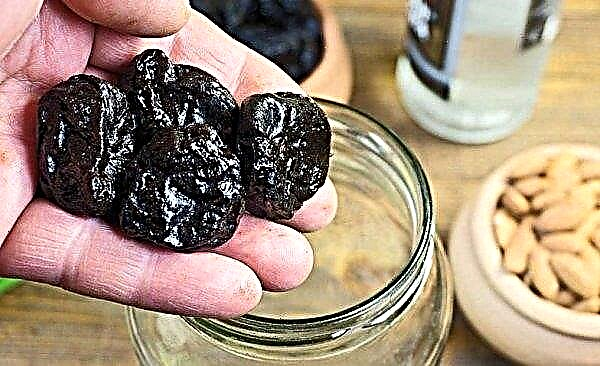Horizontal junipers (juníperus) - a culture with quite attractive decorative qualities. One of the most popular representatives of this species is the Prince of Wales. This is a fairly unpretentious and attractive coniferous bush, which has recently become increasingly popular.
Botanical Description
Juniper Prince of Wales is a variety that was created in Canada based on a short, wild-growing species. It is the lowest of all horizontal junipers. Its frost resistance is up to -30ºC, it winters without shelter. The only exceptions are plants of 1-2 years of life, grown in harsh conditions.

Variety Characteristics
Its maximum height is not more than 20 cm. This shrub does not have a central trunk, it forms shoots that are horizontally spread on the ground in a radius of up to 1.5 m. First, rarer single branches grow. As the plant develops, the upper shoots form new lashes that cover the lower ones. In this way, Prince of Wales forms a solid conifer carpet, while he develops a fairly powerful root system up to 50 cm in diameter.
Did you know? Juniper — This is a record plant for phytoncides. In one day, 1 ha of these stands produces up to 30 kg of these substances. This amount is enough to clear the atmosphere of a big city.
The Prince of Wales's growth abilities are rather modest: 5–6 cm wide and 1 cm high. At the same time, it is worth considering that near the reservoirs and in partial shade, the shrub can develop more intensively and reach larger sizes. At the beginning of the growing season, young plants have delicate green needles.
As they grow older, the bush acquires a silver hue. A characteristic feature of Juniper Prince of Wales is the ability to change the color of winter needles to purplish-plum. Thanks to this, it becomes a spectacular curiosity that looks especially beautiful against the background of the winter garden.

Another interesting property of this shrub is the fruit. These are silver-blue berries that can be eaten. As a rule, they are used as seasonings for meat and fish dishes. They include many trace elements, vitamins, essential oils. They are used for the manufacture of alcoholic tinctures. Along with cooking, these fruits are widely used in cosmetology.
Landing Features
The general principles for landing Prince of Wales are simple. This coniferous shrub perfectly adapts to any loose soil, while it may not be too nutritious or even saline. Soils with a neutral or slightly alkaline reaction are ideal. Acidic soil for several months before planting must be "extinguished" with lime or dolomite flour.
Important! In order to avoid infection of the Prince of Wales with rust, juniper should not be planted next to fruit bushes.
Prince of Wales shows its decorative properties well in open sunlight, although it acquires a larger size, growing in partial shade. The main condition is stable moisture in the soil without stagnation of groundwater. The shrub should not be planted in full shadow, because it will completely lose its attractiveness.
 You can plant the Prince of Wales in the spring and autumn, he has the ability to take root well.
You can plant the Prince of Wales in the spring and autumn, he has the ability to take root well.
Site preparation
When choosing a site for planting this plant, you need to consider that it has a large diameter. To plant Prince of Wales, you need to prepare the soil mixture.
It is better to get it in a specialized store. When preparing the soil independently, they take the same parts of peat, sod soil and sand, add ¼ part of ash or dolomite flour to the same.
Seedling selection and preparation
Juniper seedling is also advisable to buy in a proven nursery. When buying, you need to pay attention to the state of the root system. It must be well developed. When turning down, the seedling cannot freely fall out of the container. The branches should be elastic, intense in color.

Landing algorithm
To land, you must carry out a series of the following actions:
- dig a hole equal in diameter to two volumes of the root system (landing container), in height - 2 volumes plus 15 cm for drainage;
- lay drainage at the bottom of the landing well;
- fill the bottom of the pit with half of the planting mixture, compact it;
- place the seedling in the center of the hole by adjusting the position of the root neck (it should be 2 cm above ground level) to prevent the death of the plant;
- fill the hole with the remaining soil, water the plant, if the soil sags strongly, pour it.

If you need to transplant an adult plant, then proceed as follows:
- the branches are carefully lifted, tied with fabric and rope;
- dig a juniper root in a radius of not less than half a meter to a depth of 40-50 cm;
- carefully remove the shrub;
- further landing occurs according to the scheme indicated above.
How to care for a plant
Prince of Wales care rules are standard: watering, top dressing, mulching, shaping, warming. This plant is unpretentious. But it requires attention, especially in the first years of its life. At this stage, you should be extremely courteous with juniper.
Watering and feeding
Freshly planted shrubs need to be watered in the absence of rainfall daily for the first two weeks. For this purpose, it is better to use standing water heated in the sun during the day, while sprinkling is good.

Junipers are fed mainly with special mineral fertilizers, according to the instructions on the package. From the third year after the landing, Prince of Wales does not need additional nutrition, because, thanks to its powerful root system, it can extract all the substances necessary for life on its own.
Important! The first top dressing is carried out in April, the second can be carried out in the summer in humid weather. If the plant has a healthy appearance, re-dressing is not necessary, it can do harm.
Mulching and cultivation
Mulching is an important agricultural technique for the cultivation of the Prince of Wales. Without it, successful shrub cultivation is not possible. The ideal material for this is wood bark, but straw, dry foliage, mowed, dried lawn grass, and non-woven materials that allow watering are also suitable.

Loosening is carried out before laying a new layer of mulch, which must be periodically updated. At other times, it is impractical, because weeds do not grow under the mulch and a natural soil microclimate is maintained.
Shaping and cutting
Due to the slow growth, the Prince of Wales does not require frequent haircuts. In early spring, if necessary, carry out wellness pruning, removing dry or unhealthy branches. Forming cuts are made depending on design preferences. The shrub has a natural decorative effect and does not require special formation.
 Often, when cutting, they simply shorten the longest branches that violate the landscape design.
Often, when cutting, they simply shorten the longest branches that violate the landscape design.
Wintering
Shelter for the winter is needed only for young plants of the first or second year of life. For this, it is best to use spruce branches, it contributes to good snow retention. But in its absence, you can use any improvised materials: build a small shelter from arches and non-woven covering material, cover with a layer of straw at least 30 cm, etc. For a successful wintering, it is necessary to mulch the trunk circle with a layer of 15 cm in a radius of at least 50 cm .
Important! When preparing for the Prince of Wales juniper wintering, you should not forget about the moisture-recharging autumn watering!
Breeding methods
The simplest and most effective way to propagate the Prince of Wales juniper is to root layering from the uterine bush. This method is best used in the spring. To do this, you need to choose a two-year branch without cutting off from the bush, deepen it a little in the place of rooting in the soil, fix it to the soil (you can use special brackets), sprinkle with earth in the form of a knoll, mulch.
Further, it is necessary to maintain an optimal moisture balance, the same as for the mother plant. This procedure can be done with several branches at the same time. The young seedling will be ready for planting next spring.

Another affordable way to breed this coniferous shrub is rooting by cuttings. For this, cuttings up to 10–15 cm are cut from two-year-old branches in spring. They are placed in containers with a nutrient substrate, covered with transparent material (plastic, film) and germinated at an air temperature of + 18–21ºC for 2–4 weeks (until rooting).

For cuttings, you can build mini-greenhouses from plastic bottles. The main thing is not to forget about drainage to prevent stagnation of water. This method is good in that the plant can be grown in a container until planting, which can be done at any convenient time, for example, in the summer.
There are two other methods of propagation of Prince of Wales juniper - this is grafting and propagation by seeds. But in the first case, the method is not justified because of its complexity and poor survival of the scion. And in the second - the received seedlings will not inherit maternal traits. As a rule, Prince of Wales do not breed like that.
Did you know? During the Great Patriotic War, in one of the Crimean hospitals, surgeons operated on the wounded in juniper groves, using the increased ability of the plant to secrete phytoncides. After them, postoperative complications never occurred.
Landscape design application
The solid green mass of this shrub is perceived as a lawn. Moreover, the ability to grow on any soil and the ability to clean the air makes Prince of Wales a favorite plant of landscape designers. It can be used with success both for the design of urban landscapes of park areas, and for private gardens and courtyards in rock gardens, rockeries, for the design of the shores of small reservoirs.
It is good as a background for any flowering plants, looks great in long-landing on the slopes. It is successfully used as a container plant to give the decorative effect of balconies, cornices, loggias, etc.
Diseases and Pests
Juniper Prince of Wales is not afraid of virtually no illnesses other than rust. The cause of its occurrence may be an excess of moisture and the proximity of infected plants. For prevention, it is necessary to monitor the water balance.
If signs of this fungal disease, which manifests itself in the form of red growths on the needles, are detected, the affected areas should be removed, and the juniper should be treated with copper sulfate or other appropriate fungicides.

The pests chosen by Prince of Wales are a spider mite, a juniper sawfly, a shield, and aphids. Signs of their appearance is a change in the color and appearance of the needles. If pests are suspected, the plant must be inspected to determine the type of insecticides needed to control them. As a rule, all pests except the spider mite can be destroyed by one type of drug.
With the spread of the spider mite on the needles, a spider web appears. This is a very dangerous pest, which is extremely difficult to get rid of. Treatment with colloidal sulfur or other insecticides aimed specifically at its destruction is necessary. To consolidate the result, treatment must be repeated after 10-14 days.
Important! The spider mite spreads in dry, hot weather. To prevent its occurrence, frequent sprinkling with increased air dryness is necessary.
Designers fell in love with juniper Prince of Wales for their unpretentiousness to the growing conditions and decorative properties of its needles. He is especially beautiful in winter. And the ability to grow in containers is a great help for those who do not have large garden areas, but would like to adequately decorate their balcony or loggia, cornice or roof.

